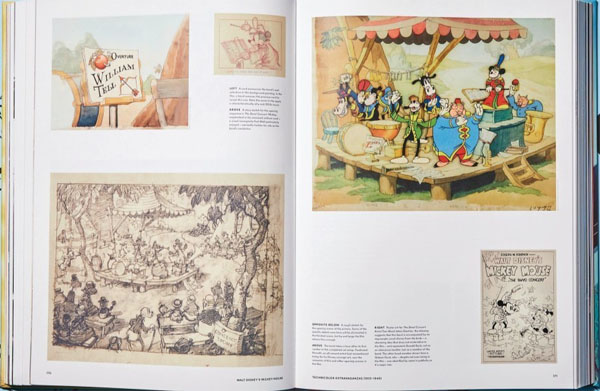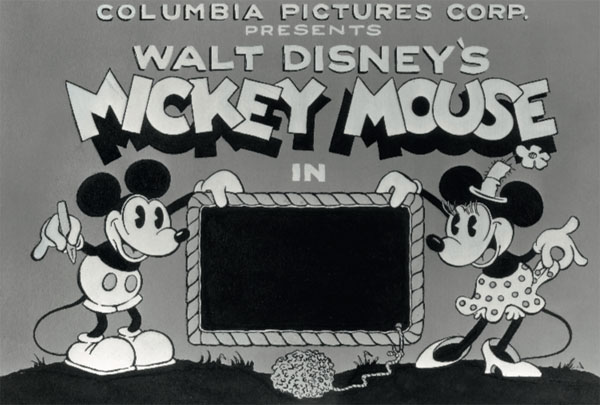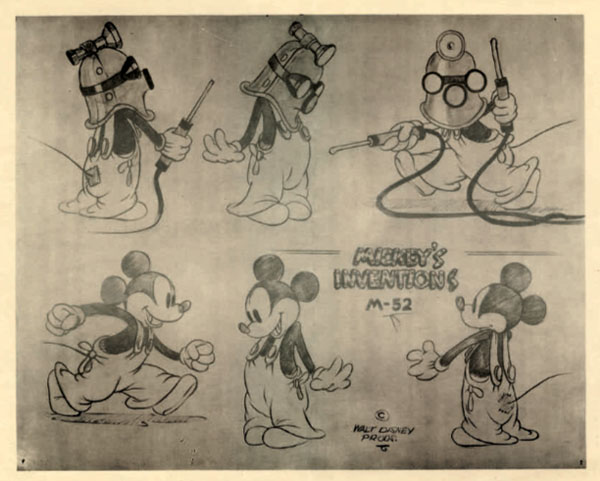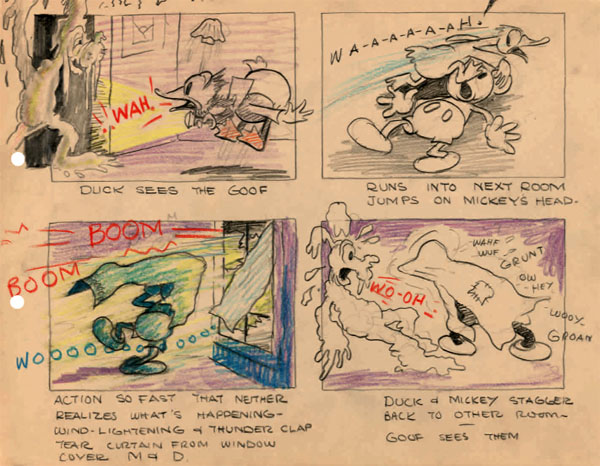
Walt Disney’s Mickey Mouse: The Ultimate History (Taschen) Edited by Daniel Kothenschulte; Text by J.B. Kaufman and David Gerstein; Design by Anna-Tina Kessler; Directed and Produced by Benedikt Taschen.
First things first: Taschen’s mega-book devoted to Walt Disney’s Mickey Mouse is a feast for the eyes – but more importantly, its a major reference work devoted to the world’s most iconic cartoon and comic star.
The book itself is so physically huge its the equivalent of reading 15 books in one – and I’m incredibly impressed by the hard work clearly done by J.B. Kaufman and David Gerstein on this mammoth volume. They are, of course, the perfect duo to tackle this project (being true experts on the title subject).
There is so much to say about it, I don’t know where to begin, but five words described my initial reaction upon a first view: Immense. Gorgeous. Groundbreaking. Vital. Fun.
Immense. In case you haven’t seen it – the book is 496 pages, oversized (11.4 x 15.6 inches), and sold in a large cardboard box – with a handle. The size immerses the reader in the subject – and in the art. With the Disney Archive and ARL providing most of the images (much otherwise unseen publicly before), aided by an army of private collectors and their collections – as well as Getty Images and Heritage Auctions – this material not only celebrates its subject, but each piece meticulously helps tell the story of the character himself, and of his role in the overall career of Walt Disney.
Gorgeous. The large size (and crisp, crystal clear printing) allow the reader to enjoy each photograph, painting, poster, storyboard and animation drawing as if the original were on display in front of you. Several double page spreads made me audibly gasp – The original art for the Columbia Pictures Mickey Mouse main title; storyboard panels from The Sorcerer’s Apprentice – to name but two. Much here to study and linger upon – and drool over!
Groundbreaking. There have been books devoted to Mickey Mouse before. There are many large oversized coffee table picture books devoted to analysis of Disney animation. But this one breaks new ground by the sheer amount of fresh reference, new research and massive detail brought to its primary subject. The text is every bit as valuable as the images and distinguishes this project through its critical length and depth.

The double page spread covering “Mickey’s Gala Premiere” (1933)
The story of Mickey is told, film by film, every one from Plane Crazy to The Simple Things (and beyond to the House of Mouse and even the new Paul Rudish cartoons) – with detail about each, illustrated with its poster (or advertising visuals) and various storyboard/cel/background/misc art. The special productions (The Band Concert, The Brave Little Tailor, The Sorcerer’s Apprentice, Mickey and the Beanstalk, etc.) get a bit more attention – as you’d expect. We learn how Walt really never lost sight of Mickey over the years – moreso than I knew before. During the forties, Walt pursued another feature berth for the Mouse, and pre-War shorts like The Little Whirlwind represented a deliberate new direction never fully revealed until now. In the fifties when it looked like Mickey was finished in theatrical shorts, Walt fortified his continued fame making him the frontman for Disneyland – as well as the star of a daily television program – The Mickey Mouse Club.
Vital. Each chapter takes the deepest of dives into various aspects of Mickey’s history, covering subjects that, on their own, could be released as separate books. Chapter 6 “Unfinished Rhapsodies” covers 45 unmade golden age Mickey Mouse cartoons, from Tanglefoot to Mickey’s Elopement, which were developed to an extent – filling this chapter with tantalizing model sheets, storyboards and plot synopses. Chapter 7 covers “Mickey on The Air” about the Mouse’s short-lived 1938 radio show – and his previous and subsequent broadcast appearances. Mickey Mouse during the War, Mickey Mouse in Features, on Television, his frequent redesigns – and a plethora of merchandising and publishing.
The writers recount how Mickey was more than animated shorts in the early 1930s — Mickey was a world wide fad! This led to the birth of the tremendous money machine that was merchandising and licensing – much of which is pictured. I love the rare photo of Disney signing his King Features contract with Ward Greene (years before Greene was involved with Lady and The Tramp) – the book is filled to the brim with such rarities.
Several healthy chapters on Mickey Mouse’s comic strip and comic book career recounts the many artists (Gottfredson, Murry, Haughton, Scarpa) and the vast variety of pen-and-ink adaptations, often portaying Mickey as a gung-ho adventurer. A story-by-story recounting of each newspaper comic strip continuity, Mickey Mouse Big Little Books, Mickey Mouse Magazine, vintage English, German, French and Italian Mickey publications – are all covered.

The spread covering “The Band Concert” (1935)
Fun. It’s just a pleasure to browse. To dip in. To review. But more importantly, I came away smarter about Mickey and Walt – and smarter about the Mouse’s place in popular culture and Hollywood history, in American culture, and to the culture of the world in the 20th Century. The book is not only eye candy – but ‘brain candy’ as well.
Everything is here – and more. It’s a feast. A must-own. For animation information, its a Disney-Archive-on-Demand for your book shelf. Bravo to Taschen (and David and J.B.) for producing this epic publication. Nothing less than perfect – and I think that’s just the way Walt would’ve wanted it.
A Sampler of Several RARE Images from this Book

Imagine this Columbia Pictures main title on a double page spread, in your face, filling your peripheral vision…

Model Sheet from the cartoon that would later become Donald’s MODERN INVENTIONS (without Mickey)

Walt Kelly story sketches for a film that would later become LONESOME GHOSTS

Film frame of the original title card for CLOCK CLEANERS
So what are you waiting for? Amazon has it on sale – click here.


 Jerry Beck is a writer, animation producer, college professor and author of more than 15 books on animation history. He is a former studio exec with Nickelodeon Movies and Disney, and has written for The Hollywood Reporter and Variety. He has curated cartoons for DVD and Blu-ray compilations and has lent his expertise to dozens of bonus documentaries and audio commentaries on such. Beck is currently on the faculty of CalArts in Valencia, UCLA in Westwood and Woodbury University in Burbank – teaching animation history. More about Jerry Beck [
Jerry Beck is a writer, animation producer, college professor and author of more than 15 books on animation history. He is a former studio exec with Nickelodeon Movies and Disney, and has written for The Hollywood Reporter and Variety. He has curated cartoons for DVD and Blu-ray compilations and has lent his expertise to dozens of bonus documentaries and audio commentaries on such. Beck is currently on the faculty of CalArts in Valencia, UCLA in Westwood and Woodbury University in Burbank – teaching animation history. More about Jerry Beck [



































It looks like whoever was responsible for handling the title artwork fixed the error in the chalkboard border that plagued the Columbia Mickey Mouse titles when the titles were redrawn to fit a lighter tone of gray, since likely ‘The Chain Gang’; it survived as late as ‘Barnyard Olympics’!
https://i.imgur.com/seW1Z8E.png
(Note: look right below the “L”….)
Actually, no…. that “error” appears to have been entirely separate from the title artwork! Notice how the chalkboard border is white in that shot I just linked, where here, it’s gray….
It must have been that someone wanted to avoid destructively destroying the title artwork when wanting to make improvements, so the “white” parts of the chalkboard border must have been put on a separate cel, which appears to be missing here. If you flash back to the earlier Columbia titles with the darker background, the chalkboard border’s color is just like what is seen in this article:
https://vignette.wikia.nocookie.net/disney/images/f/fa/Shindig1.jpg
And of course, the error is missing there as well.
From the looks of it…. this does appear to be nondestructive editing. Notice how the title artwork is also missing the thick borders around the typography at the bottom and the extra patch of grass on the bottom, seen as early as ‘Pioneer Days’. The last time the artwork would have been destructively edited, i.e. modified directly would have been around ‘The Shindig’, where everything sans the background matches the image shown here.
Before, in ‘Fiddling Around’ from up to that point, the title artwork initially had no borders around the typography at all. So, once again, nice find from Kaufman and friends, and thanks to Beck for posting!
Not sure if the book mentions this or not, but I’m going to take a very high guess that for the Columbia period, the opening title artwork was all Win Smith and that the later end title artwork (that first appeared likely in ‘The Chain Gang’) may have traces of Ben Sharpsteen. Smith is easy to identify while Ben’s illustrated work is more subtle but more apparent when you look close.
Okay, I legit can’t figure out what “error” you guys are referring to regarding the chalkboard border.
This looks like a fantastic tome!
Additionally, I wish one of our experts here at Cartoon Research would enlighten us with more information on Mickey Mouse’s radio program. (I very much enjoyed Devon Baxter’s series on OTR a while back!)
I know Korkis did a large article about “Mickey Mouse on the Air” on Mouse Planet which was later published in his first “Vault of Walt” book.
Keith Scott wrote a lengthy piece on “Mickey Mouse Theater of the Air” for ANIMATO magazine back in the late 1990s. It could be a great idea for a topic for Radio Round-Up, indeed…
Although I haven’t read the book yet, from looking through it, I really think it’s a very good book. However, I’m a bit disappointed it didn’t say anything about the Walt Disney World attractions such as “The Mickey Mouse Revue” and “Mickey’s Philharmagic”. Hopefully, when Taschen does a large Walt Disney World book, they will include those attractions (and also the “temporary” Mickey’s Birthdayland which became Starland and them Toontown Fair).
I don’t have the book yet, but I heard from one reader that Mickey’s voice in some early-1950s shorts was provided NOT by Jimmy MacDonald, but by none other than Clarence “Ducky” Nash. Shoulda guessed, given that MacDonald’s Mickey has a slightly higher tone compared to the other one.
Clarance Nash voiced Mickey in at least one 30’s short (I forgot which one), because Walt was in Europe doing distribution business deals.
Just got this beautiful book based on this review. I didn’t actually know about it before, but was intrigued and these things do tend to go out of print. It is indeed very large, but is not nearly as heavy as it looks. That’s because it’s still only roughly a 450-500 page book, with good thick matte stock pages. As the review mentions though the sheer size does tend to make it very engrossing to read. And when done reading it will have a very striking appearance on a coffee table or display shelf.
The original title card for the Clock Cleaners looks as spectacular as the short itself. Why Disney choose to remove this form of circulation I will never know.